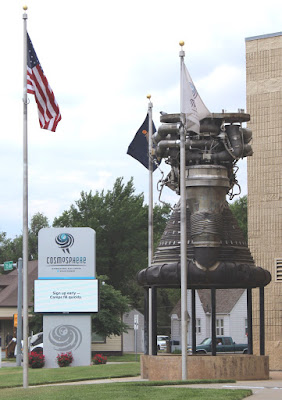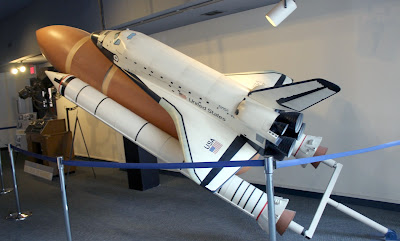But you will indeed be in Kansas, because the museum, a fascinating walk through the history of the world's space programs, is located next to the community college in Hutchinson, Kansas. Click on the images to make them larger.
A visit to the museum is definitely a learning experience, I know this because as I was reading the informational displays on the exhibits, I kept saying aloud, "I didn't know that." The research and the presentation of the displays are incredible, not always reinforcing what we were taught in school history classes or even movies and documentaries about the American space program.
The first two things you see when you walk in the front door are a full-size replica of the Endeavor space shuttle and an actual SR-71A Blackbird stealth aircraft, hanging from the ceiling (with some ground support). The impact of seeing this is not subtle. There is also a NASA T-38 Talon jet aircraft up there, but it's small compared to the other two.
The museum offers a variety of paintings and works of art to accompany the theme of the museum, with most of them spotlighting the international contributions to space flight.
But the exhibits also spotlight the many achievements of individuals who made it all happen.
The largest number of items on exhibit are just "things" with buttons and switches and lights and, while no doubt they played an important part in the space program, it is not immediately obvious what they are and what they did. Even after reading the detailed explanation on the nearby signage, you nod in appreciation of how important they were, but you still don't know what they are or what they did.
The cockpit instrument panel of a SR-71 Blackbird.
The exhibits start off telling about the early "rocketing enthusiasts" of Germany who, when World War II broke out, became very important to the development of the V-1 and V-2 ballistic missiles which Hitler used to great advantage in his war with Britain.
Once the Allies figured out what he was up to, huge bombing runs over Germany sought to disrupt and destroy the development and production of the V-2 rockets.
Special displays tell of Werner Von Braun and how distraught he was to work with the Nazi's in the development and use of the V-2 rockets. As the war was drawing to a close and the Allies were storming into Germany, Von Braun and his team of key rocket scientists and engineers came out of their secret hiding place and surrendered to American troops.
And suddenly, the war ended.
The German scientists were taken to the United States and began working for the American rocket program, which eventually became NASA. Working with American engineers and technology developers, Von Braun and his fellow rocket scientists were responsible for many of the early U.S. space program successes.
The Russians became extremely angry that the German scientists surrendered to American troops instead of their own troops, and felt that the United States had "stolen" the rocket design and building experts from them. While the Soviets captured all the rocket production facilities and many of the remaining rocket production crews, they felt cheated by not gaining access to many of the design blueprints and production documents. It became tense, and that feeling lasted for decades.
American rocket development accelerated at a rapid pace, aided by a "rocket sled" and other human tolerance testing equipment (see above photo) that sought to determine how many G-forces a human being could withstand. There were test flights, spinning gravity simulators, and all kinds of other experiments, getting folks ready for "faster than sound" flight.
And then along came Sputnik, the first artificial Earth satellite. The Soviet Union launched it into an elliptical low Earth orbit on October 4, 1957, scaring the wits out of complacent Americans who were a little nervous when they could look up in the American sky and see a Soviet satellite passing overhead. Things began to really heat up after that.
The exhibits then branch out into the actual space programs, the first astronauts, the first cosmonauts, the successes, the failures, the hopes and dreams, and then the statement by President John Kennedy that Americans would land a man on the moon by the end of the 1960's. That was quite an ambitious challenge, given the status of the design, building and testing of components at that point.
The museum features room after room after room filled with exhibits that are actual hardware, space suits, space capsules, gear and various kinds of equipment, all explained in great detail. One exhibit is an actual "clean room" where astronauts were able to climb into the capsules atop massive rockets that would blast them into space. The "white rooms" were attached to huge launch gantries and provided a bridge from the elevators to the capsule. Another exhibit is an actual Apollo capsule.
And, of course, we all remember this piece of hardware, the "Eagle."
Probably a replica since the bottom part is still on the moon somewhere.
As well as a replica of the famous "moon buggy," also still on the moon somewhere. It kind of reminds me of the foot-powered car that Fred Flintstone drove around in.
The "Space Photography" exhibit explained the various cameras, the different sizes of negative formats, and the other specialized equipment used to take pictures on the moon missions and orbital adventures.
Every space museum has some kind of international space station toilet exhibit.
Fashions worn by International Space Station occupants
A large scale model of the Space Station itself
At the end of the tour comes a room filled with exhibits of the work being done by "private space exploration companies," Spaceship 1, and other efforts by private corporations.
Overall, the Cosmosphere is a great experience. There's a lot to read, a lot to think about after reading, and a diverse collection of hardware, big and small. Here are some additional pictures.
For more information about the museum, visit its website at Cosmo.org. And when you are finished visiting the Space Museum, you can drive several blocks over to the underground salt mine tourist attraction where you are lowered some 600 feet into the earth to see where salt comes from. That's pretty deep.

























